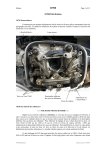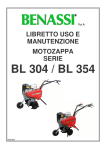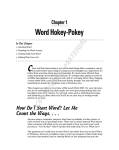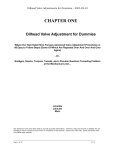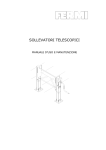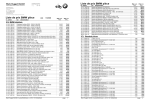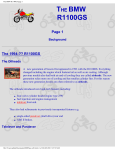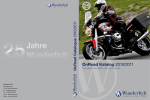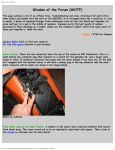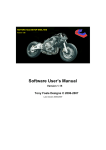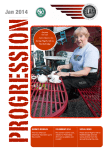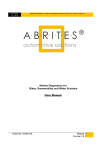Download R I P A R A Z I O N E C A M B I O R 1 1 5 0 G S
Transcript
RIPARAZIONE CAMBIO R1150GS Dal forum http://www.advrider.com/forums/forumdisplay.php?f=50 bemiiten 26/11/2006 R1150GS 2000 At 55000 miles (88000 km) my '00 GS has it's first major problem. It seems to be coming from the transmission. http://www.youtube.com/watch?v=CShKkyGnLGY The noise disappears soon as the clutch is pulled in. Rolling in neutral with clutch out, the motor will not make the grinding sound worse. Sounds a little rocky in neutral, but soon as it's under a slight load all hell brakes loose with a nasty rhythmic rumble/grinding sound. Trans shifts perfect. Oil is new & full. Sounds too bad to be the push rod bearing. Anyone had a similar experience with an oil head 6 speeds? I'm tearing into it to check the driveshaft first. Let you all know what I find. JimVonBaden 26/11/2006 R1200GS 2005 Yes, that doesn't sound right at all. Way more than the typical rumble at idles. Just off the cuff, it sounds like a clutch plate coming apart. But it is hard to say. Ricardo Kuhn 26/11/2006 I'm pretty sure the rivets on the clutch making contact with the other two plates. If the problem was on the shaft you will still ear similar sounds since the shaft never stops rotating. bemiiten 27/11/2006 R1150GS 2000 It's not a bad u-joint. Too easy. I don't think it's a clutch problem either. The sound stops when the clutch is pulled, but it means the input shaft unloads and stops spinning. The video is a little deceiving. I was trying to recreate the sound by applying some rear brake in gear to simulate a load. The sound of the trans teeth rattling overshadow the cyclic rumble that is best heard in the last 25 seconds of the recording. This rumble is much worse under load and sounds like a bearing running with no lubrication. The sound has me convinced it's a trans shaft bearing. Input shaft bearing perhaps? Beginning to wander if this has something to do with it. No choice now, but to pull it off and open the tranny and have a look. 1 of 15 Banjax 28/11/2006 R1150GS My 1150 sounds just like that as well. On centerstand, gear engaged, let out clutch. Bag of spanners in the washing machine. What does it sound like when you ride it normally on the street? Is it the same? Mine sounds normal under these circumstances. I have been told that the angle of the drive shaft when on the stand is too much and it creates noise. That and the motors power pulses thru the transmission when its unloaded cause vibration. Gros Buck 03/12/2006 R1200GS ‘05 I own a 05 1200gs that does the same thing. I heard Getrag transmission does that all the time. I double check with another GS at my dealer. Same noise whenever you put the bike on central stand with the wheel engaged and spinning in the back. This noise could be reduced with thicker oil. But I agree it does not sound healthy. JimVonBaden 28/11/2006 R1200GS 2005 Just to be clear. In gear? Clutch handle released? Was it on the centerstand with the rear wheel free spinning? Does it do it under load? Does it do it with the trans in neutral and the clutch handle released, pulled in? bemiiten 28/11/2006 R1150GS 2000 The video shows the bike on the center stand, wheel spinning in first gear. It is normal for the trans to make a lot of noise under this condition, but not on the road with a steady smooth load. When the bike is in neutral, it really isn't too noticeable. Put the bike in any gear and apply a load from slight to full out, and it is a horrible, unmistakable cyclic grinding. Sounds like choo choo choo choo.... It speeds up with road speed. Pull in the clutch and it all but disappears. The noise started while riding this weekend. By the time I was sure I was hearing something wrong and pulled out the earplugs to confirm, I was 75 miles from home. I rode it back with no issues except the grinding. Convinced that it is a trans shaft bearing. I hope I can find evidence when I open the trans. Pulled the black magnetic drain plug on the bottom of the trans to find it filled with fine metallic fuzz, but nothing any bigger. I never pulled the magnetic drain plug before and I wished I had. So if you have a 1150 do yourself a favor and clean it off next service. The bearings in the trans are sealed, which means any grindings should stay in the bearing. The leak at the clutch housing has been there for 15,000 miles, I figured it to be the rear main seal ring, because I could not detect any gear oil smell. bemiiten 29/11/2006 R1150GS Here's a trick to help get the clutch disk centered. Trace around the pressure plate with a pencil, and you can use the marks to confirm the disk is centered, assuming the same disk is going back in. 2 of 15 Not so sure about this one. Manual shows a wear limit of 4.8mm , this one measures 6.3mm. Looks like the rear main seal ring is not the source of my leak. The trans input shaft. The trans input seal on the other hand... 4wheeldog 29/11/2006 Looks to me like you may have the input shaft spline problem. Your clutch disc splines look worn out, and the input shaft appears to have a lot of taper. Did you have problems shifting? bemiiten 29/11/2006 R1150GS 2000 Bike shifts fine. Splines look OK in person. I did a spline lube at 35k. At 55k the splines are dry again, even after using the Honda molly 60. The spline wear looks about the same as before. bemiiten 01/12/2006 Smoking gun found! R1150GS 2000 I use a long drift (ndt: cacciaspine) to drive out the two pins where the two halves of the trans mate. I heat up the case first to loosen them up a bit and add a little penetrating fluid. They take a considerable whack to move so the heat seems like a good idea even though the manual makes no mention for this step. I use two heat guns for 15 minutes. This laser temp reader takes out the guesswork. After about 30 minuets I'm reading 170°F (75°C). I decide to give it a try. The back half of the trans slips off easily by hand. Sweet! 3 of 15 Next order of business is to heat the bearing points in the rear cover. My biggest fear was to go through all this and not be able to detect a bad bearing. All the rear bearings are turning smoothly and seem fine. I start heating the front case. And heat some more and some more. It shows 205°F (96°C). Around 220°F (105°C) the input and output shaft bearings are moving easy ready to drop out. The intermediate shaft will not budge. I go at it for an hour and a half with temps up around 230°F (110°C) with no luck. I'm frustrated. Give the heat guns another try. I concentrate all the heat on the intermediate shaft. 260°F (125°C) and still no give. I support the intermediate shaft by holding it in one hand with a set of gear puller jaws. I elevate the entire assembly off the bench and, not wanting to play it too safe, give the back of the bell housing a few whacks with a rubber mallet. Finally it relents after a dozen of so soft blows. I am relieved to see the intermediate bearing clearly looks and feels completely buggered. No doubt , This is the culprit! All three front bearings show signs of discoloration , but only the intermediate feels bad. Intermediate shaft (7 gears) Input shaft (1 gear) Intermediate shaft, front top. Output shaft (6 gears) 4 of 15 bemiiten 02/12/2006 R1150GS 2000 Here is a pic of the metallic fuzz on the black magnetic drain plug found at the bottom of the transmission. When I discovered the problem, first thing I did was to remove the fill plug to inspect the oil level. It was fine. Next I drained the gear oil into a clean pan to check for debris with a magnet. There was a little bit, but the small amount of fine metal particles in the hot oil would give me little concern normally. I never removed the black magnetic drain plug on the bottom of the trans before, because the cat needed to come off to gain access. I found a short 3/8 bolt that has a 9/16 hex (14 mm) fit's perfectly. I put on two nuts and used a wrench to remove the plug with the exhaust in place. I would soon find out that despite the service manual making no reference to remove and clean this plug for normal maintenance, not doing so was a major blunder on my part. The plug was absolutely filled with super fine metallic fuzz. I cleaned it up, refilled the trans and decided to take the bike for one last ride around the block to listen to the grinding noise one more time and to shoot the video. I should mention I drained the final drive just to make sure that the noise wasn't being transmitted somehow to the trans. Nothing at all was found on the drain plug. Here is a picture after I cleaned the trans plug once already. I rode the bike less than a mile and managed to pic up this much more debris!!! You can bet that this will be coming out at every service from now on! Jim Bud 02/12/2006 R1150GS ADV Other than the bearing..... the rest of the trans looks to be in pretty good shape. It’s possible your box started out life with a problematic bearing? I think I will check my magnetic plug next time. Dropping the exhaust system is not all that hard. It will give me a reason to take off the center stand and give it a complete lube/rebuild. bemiiten 02/12/2006 R1150GS 2000 This is the oil recommended by the dealer. I normally use what is called for in the manual. I already was using the 75/140 before I discovered the fact that it calls for 90w. This issue has been debated here before. Over the years, the container has been changed but what came out looked the same. BMW's latest lubricant is now red in color where the old stuff was the normal gold/brown color. This set off alarm bells at my last fluid change. 5,000 miles later, bearing failure. So I'm left wandering why shit happens. 5 of 15 So what do you think? ● The fuzz found in the oil it's way into the bearing and destroyed it. ● The large amount of fuzz is from the bearing failure. ● The bearing was improperly shimmed at the factory, but took 55k to fail. ● The catalytic converter's excess heat played a role in cooking the bearings. ● Changing to the red oil did it!!! ● The case is improperly machined, hence the reason the bearing would not come out while all the rest were falling out at a much lower temp. ● Shit happens Just a few of my opinions: - The fuzz isn't a concern unless it had very discernable chunks, or flakes of metal on it. - Normal wear and tear, along with break-in will create very small fuzzy particles that nicely stick to the magnetic pick-up. - The different color of your oils means nothing. They have different colors so I wouldn't worry about that. - I would bet that it was just your time. It seems like you did all the correct maintenance, so I wouldn't blame yourself. My plan for shimming consists of carefully measuring the assembled length of the existing shafts. After the bearings are removed, I will compare them to the new ones as well. This should hopefully result in me being able to match the same size that came out. One big assumption here is that they were shimmed properly to begin with! This is uncharted territory for me so any knowledge or suggestions would be greatly appreciated. AntonLagiader 21/03/2007 R100PD Don't assume anything is shimmed right. Every 6-speed I've worked on is loose somewhere. The manual I have does give shaft lengths but that doesn't mean much. I always check them the old-fashioned way: shaft protrusion (ndr: sporgenza) vs. cover depth. I've measured a bunch of cases and covers and have a decent idea of what they should be. They're generally repeatable within about 0.05mm. Again, none of the numbers mean anything. Measure your parts as if it were an Airhead tranny. slideways 03/12/2006 The bearings are pressed on the shafts and interference fit into the cases. For installing the bearings on the transmission shaft I would put the entire axle in the freezer over night. Then find a socket that matches the inner race on the bearing and heat it red hot on the stove. Put the hot socket on the inner race for a minute then pull the shaft axle out of the freezer and the bearing should slide right on. When installing new bearings into the cases I always put shaft with bearings in the freezer over night and usually they just drop into the cases. If you need to extract any blind side bearings from the transmission cases, use bearing puller. johnjen 03/12/2006 While the original shimming will still be close, changing the bearings will usually change the shimming measurement. If you want to use our method, try this; - At room temperature make your measurements (write them down). 6 of 15 - Then freeze the parts and re-measure the shimming dimensions while really cold. - Then heat the parts up to say 200°F (93°C) and measure them again. - Then determine the range of the shims from cold to hot. - From here you can either split the difference or weight the shim dimension more towards the hot side (where the tranny usually operates)... bemiiten 28/12/2006 R1150GS 2000 I had one (front) intermediate shaft bearing that was clearly bad and a leaking input shaft seal. The other two front bearings also show sings of overheating with the output shaft bearing discolored as bad as the intermediate, but turning smoothly. I decided to replace all six. The parts have arrived from Chicago BMW 3 weeks after I placed the order. I set up a dial indicator to measure the overall length of the assembled intermediate shaft. I get repeatable results with this method. I also used a digital caliper to measure overall length, but found the results to be too varied to fully trust. The intermediate shaft was placed in the freezer while I heated a 1" set collar on top a kerosene heater. The manual shows pulling the bearing with a puller, but I decided to do the removal with a press instead. I removed the frozen shaft and placed it on top of the heated set collar to warm the bearing for a few minuets. I installed the bearing clamp and put the assembly in the press. The clearance between the gear and bearing is extremely tight. As soon as the bearing moved a little, the clamp was tightened to allow a better bite. The freezing and heating paid off when the bearing came off nicely without excessive force. 7 of 15 The original failed intermediate bearings are from Japan. The replacements are from Poland (same part#). The original output shaft bearings are from England, the replacements are also from Poland (updated part#). All the bearings new and old measure the exact same thickness. Better don’t use the caliper, it is sensitive to hand pressure (and I'm sure that's the .001 difference). After a more accurate measurement with a dial gauge, the bearings were indeed the same size. All the bearings seem to be made to very tight tolerances. Old bearing New bearing To my thinking, this means I am replacing apples with apples and their should be no reason to reshim the shafts, right? Wrong! After allowing the shaft to warm back up to room temperature, I'm showing a difference of about .007" shorter. The manual list a maximum difference of .002". 8 of 15 The manual gives no absolute overall dimension for the shafts, and no inside dimension for the trans case. Just a .002 figure that I assume is endplay. I can only compare what I had to what I have now. AntonLagiader 21/03/2007 R100PD Don't assume anything is shimmed right. Every 6-speed I've worked on is loose somewhere. The manual I have does give shaft lengths but that doesn't mean much. I always check them the old-fashioned way (shaft protrusion vs. cover depth). I've measured a bunch of cases and covers and have a decent idea of what they should be. They're generally repeatable within about 0.05mm. Again, none of the numbers mean anything. Measure your parts as if it were an Airhead tranny. bemiiten 28/12/2006 R1150GS 2000 Here is the procedure I used for installing the bearings. I start by using a washer to absolutely guarantee that no force is exerted on the outer race. I freeze the shaft and use a heat gun on the new bearings. When the bearings hit about 150°F (65°C), I carefully line up everything in the press. It is easy to feel when the bearing is fully seated. Next up is the output shaft. The bearings are removed along with the adjoining gears. 9 of 15 I follow the same procedure as before and wind up with similar results. About .006 shorter overall. This should read zero, the bearings are the same size. ?? ?? One step I failed to take was making sure the old bearings were pressed fully home. It's in the manual, but I neglected this step. It's the only possibility I can think of. I'm very confident the bearings are the exact same size. Last is the input shaft. Like before, a comparison of old and new bearings show them to be exactly the same. Old bearing New bearing While inspecting the transmission engagement dogs on the other shafts, I could not help but be impressed at just how good the condition of these parts were. This can't be good! This is the thrust block of the input shaft disassembled. Check out that nice crack on the left ear! I suppose it could be just a gouge, but it extends to far to be from some debris getting in between the mating surfaces. It is on the power side. There is just no way this can go back in. 10 of 15 After 55k and one spline lube at 35k, the input shaft splines look like they have some life left in them. The clutch disk splines look a bit worse. I decide that replacing just the disk will accelerate the wear on both parts with their mismatched matting surfaces, so it makes sense to replace both while the trans is apart. Their is a lot of debate over the toughness of BMW's dry clutch. I don't abuse my clutch , nor do I hesitate to slip it as much as needed when the situation calls for it. Compared to a new disk, the friction material shows very little wear and in my case, would probably outlast the splines by a wide margin. Old clutch measures 6.32 mm, new one 6.70 mm. Manual shows a wear limit of 4.8 mm. Old disk New disk 11 of 15 bemiiten 21/03/2007 R1150GS 2000 The manual calls for no more than .002 deviation from an end play value it does not give. I decided that if the bearings are exactly the same as what came out, then that is my better bet then to base shim size on inaccurate information. bemiiten 13/01/2007 R1150GS 2000 Still waiting on one last part, I post some pictures of the failed transmission shaft bearing. At the left is the culprit bearing. You can see that the sealed bearing is out of it's lubricant. The seal shows metal shavings from the failure. Middle one is same (made in japan) bearing as left, also looking like it has some shavings and not much of whatever it is they pack these with. I do see what looks like, the red trans fluid on the bearing cage. Maybe the synthetic penetrates the seal and dilutes the grease? The last on right is an output shaft bearing made in England. Looks like it has much more lubricant left then the other two bemiiten 21/03/2007 R1150GS 2000 I noticed this little bite out of one of locating pin bores (ndt: fori). The trans housing precludes setting your drift (ndt: attrezzo spina d’allineamento) for a straight shot. Had to use a smaller 3/16 (4.75 mm) drift at an angle and it resulted in this. BMW must have an offset drift for this as I recall it didn't make sense to drive the pin from the opposite side. Anyway this picture is after I removed a small aluminum burr (ndr: truciolo). Poolside 21/03/2007 What am I looking at here? Is this a spherical head pin? Used to drift the case halves apart? If so, next time (you may rebuild one for a friend) put an inverted cone shape on the drift. Use a piece of cold-rolled rod the diameter you want and face drill it for the inverted cone shape. And radius the circumference of the face on a stone wheel. bemiiten 21/03/2007 R1150GS 2000 Thanks. The problem was not being able to use the proper size pin due to having to cock it in the bore, because part of the trans case is in the way. This resulted in the punch nicking the case, visible at the top of the pin. It was an air angle grinder punch by the way. I’ll apply the appropriate kink next time. 12 of 15 bemiiten 21/03/2007 R1150GS 2000 After searching around, LOCTITE 515 is what I decided on for a gasket sealer. I made the decision to install the seals in the cases before hand. The depth of the rear output shaft seal is critical as there is a oil hole that could be covered if its driven in a few mm too far. Installing the seals first means that caution must be taken when heating the cases that the seal is not directly exposed to the blast of the heat gun. I used sockets as a shield. I also covered all the splines with a plastic wrap to protect the seals during assembly. I used gear oil sparingly. I clean the gasket surface with proper solvent and make sure I have everything oriented properly. With the assembled transmission shafts still in the freezer, I begin to heat the front case with 2 heat guns. Getting all three shafts plus one shift fork into case all at once is a little tricky. The laser thermometer is very useful to decide when you are ready to install the shafts. The case must be hot enough for the bearings to freely slide home. I neglected to take pictures because I wanted to get the transmission assembled and the cases torqued as quickly as possible to take advantage of the rapidly warming transmission shafts. With the seals already in place, I want to use as little heat as possible so as to not damage them. When the shafts and shifting mechanism are installed, I apply the Loctite 515 to the front case. I heat the rear case and slide it home paying attention that the seals are started properly. Torque the case bolts in a crisscross manner and drive home the two drift pins last. I let the gasket sealer set before filling the transmission with gear oil. 13 of 15 To complete the mid life refreshing, here are the parts that were replaced. I coat the splines with Honda molly 60 a little more generously then the first spline lube because the splines looked dry again after only 20,000 miles. I put a dot of red paint on the driveshaft to make it easier to confirm I have phased properly. Make sure the ends of the retaining ring for the Paralever boot are in the horizontal axis to avoid interference. I replaced the rear Paralever pivot bearings that were overdue for replacement. The front were still good. I cheated and used blue Loctite for the stationary pivot, and nothing on the adjustment side to facilitate adjustment later if needed. An other small dot of red paint on the pivot and adjustment bolts will give me a visual confirmation that nothing is loose. 14 of 15 I spent an other $100.00 to replace a perfectly good clutch slave cylinder. That little bearing has seen about a bazillion revolutions, Hmmm. Doing some preventive maintenance, I decide to clean up some of the rust on the clutch line. bemiiten 04/04/2007 R1150GS 2000 First ride and the bike's shift action is really smooth. I put in a new indent arm and spring because they cost under $20.00 for the pair. I did detect the slightest unhappiness with the old one when turning the roller under pressure. Between that and the new splines with fresh lube, shifting seems better then before. When I first rode this bike, I thought the clutch action was a little grabby. After a while it worked very well. I was worried the new clutch plate might be grabby until broken in. That isn't the case as right out of the box the clutch has very good feel without a hint of gabbiness. I also made a switch to synthetic dot 4 in the clutch. So only a few hundred miles so far, but everything is dry and sounding good. A summary. The biggest issue with this job was the wait for parts. About 3 weeks. Partially my fault for not ordering everything the first time. I did not expect to have to replace the thrust block on the input shaft. +3 weeks. Screwed up the clutch line, my fault. + 3 weeks. Being that the weather was still really lousy here, it was not a big deal but if it had been prime riding season... In the end, I am assuming the failure stemmed from the bearing using up all it's lifetime lubricant. 15 of 15















